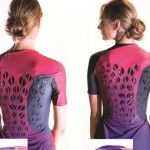 The last year or so have seen some fascinating developments in the world of smart clothing, with various teams developing garments with the same kind of monitoring capabilities we have come to enjoy from wearable devices.
The last year or so have seen some fascinating developments in the world of smart clothing, with various teams developing garments with the same kind of monitoring capabilities we have come to enjoy from wearable devices.
Now, a team from MIT have developed a breathable garment that they believe will be the best of its kind for athletes looking to regulate their body heat.
The garment has ventilating flaps built into it that open or close depending on the body heat and sweat levels of the wearer. Each flap is lined with microbial cells that change depending on humidity levels.
Smart materials
The work behind both the garment and a similarly cell-lined running shoe were outlined in a recently published paper. The approach is interesting because live cells require no extra elements in order to sense and respond to humidity. What’s more, the cells are also safe to touch and consume. They can also be produced very quickly and in the kind of quantities demanded of sports manufacturers.
Once the team discovered the sense and respond capabilities of the cells, they printed parallel lines of them onto a sheet of latex to expose them to moisture. When exposed to steam, the cells expanded, whilst they shrunk when exposed to heat. After over 100 such tests, the team wanted to place them into a wearable garment.
“People may think heat and sweat are the same, but in fact, some areas like the lower spine produce lots of sweat but not much heat,” they say. “We redesigned the garment using a fusion of heat and sweat maps to, for example, make flaps bigger where the body generates more heat.”
The garment has been tested out on both runners and cyclists, with the flaps correctly opening up after five minutes of exercise as the wearer became hot and sweaty. Sensors attached to the athlete found that the outfit did indeed successfully remove sweat from the body and lower skin temperature, and significantly more so than a control group in normal sports clothing.
Smart trainers
The technology was then tested out on specially designed running shoes. The flaps were sewn into the shoe at the point where the bottom of the foot comes into contact with the sole of the shoe, with the flaps designed so as not to come into contact with the runner’s foot. The flaps themselves were designed based upon heat and sweat maps of the foot.
“In the beginning, we thought of making the flaps on top of the shoe, but we found people don’t normally sweat on top of their feet,” the team say. “But they sweat a lot on the bottom of their feet, which can lead to diseases like warts. So we thought, is it possible to keep your feet dry and avoid those diseases?”
The next step is to work with a sportswear company to try and manufacturer the garments en masse. It’s believed that the team have already considered factors such as how to clean the garments, so if they can make them affordable then there would appear to be potential. They also believe that they could branch out into similar fabrics, such as bedsheets, lampshades and curtains.
“This work is an example of harnessing the power of biology to design new materials and devices and achieve new functions,” they conclude. “We believe this new field of ‘living’ materials and devices will find important applications at the interface between engineering and biological systems.”